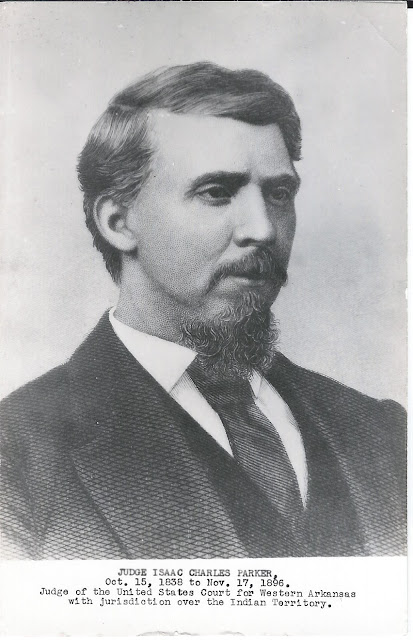One of the most notorious, or notable; depending on your viewpoint, characters to come out of Arkansas' history is Judge Isaac Charles Parker. Not a native of Arkansas, he became synonymous with its history as a judge for the United States District Court for the Western District of Arkansas. He presided as judge over that court for 21 years. His notoriety is such that he has been portrayed in works of fiction like True Grit by Charles Portis as well as novels by Larry McMurtry and Loren Estleman.
During his tenure as judge he tried 13,490 cases, 344 of which were capital cases. In those capital cases, Judge Parker sentenced 160 to death by hanging. Only 79 of those sentences were carried through (less than 50%) and resulted in his reputation as a "hanging judge." That may have come more as a result of the gallows he used which could hang as many as twelve at one time.
It should be noted, at that time, the two crimes that carried the death penalty were rape and murder. Judge Parker said of the hangings, "It was not I who hung them. I never hung a man. It is the law." Essentially true as hanging was mandated for murder and rape.
Called one of the first advocates of victims' rights, the judge reserved his sympathy for the victims of crimes. Even though his reputation was that of a hard man, he was fair, often granting retrials that resulted in acquittals or reduced sentences.
Isaac Parker was the youngest person ever to hold the position when he was appointed to the federal bench at 36 years of age. His salary was $3,500 per year. Court often lasted from 8:30 in the morning until dusk or even after dark.
He was given only 200 federal marshals to patrol a territory of almost 74,000 square miles with a population of about 60,000. Of those 200 marshals, 65 died in the line of duty. A United States Marshal's pay was $90 per month.
An interesting book to read is Hell on the Border copyrighted in 1953 by Frank L. Van Eaton. The title page pretty much tells you it is "A history of the Great United States Criminal Court at Fort Smith and of Crimes and Criminals in the Indian Territory and the Trials and Punishment Thereof before his honor United Sates Judge Isaac C. Parker 'The Terror of Law Breakers.' Embracing the Leading Sentences and Charges to the Grand and Petit Juries in dome of the most famous cases in the world's history." The book is out of print but I found it easily on both eBay and Amazon. There are quite a few pictures and many of the more famous cases are detailed as well as biographies of court officials and a history of the court.
As you may note in reading various histories, the numbers do vary. Some say over half his Marshals were killed and others also have a higher total of persons hanged. I chose the more conservative of the numbers in writing this blog post.
Sources:
The Arkansas Handbook by Sutherlin, Diann ©1996, Fly-by-Night Press
Fort Smith Historical Society: http://www.fortsmithhistory.org














